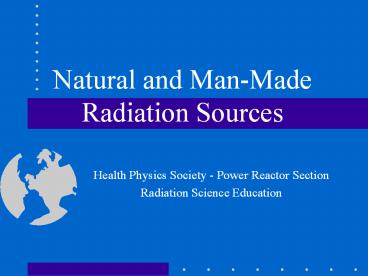Natural and Man-Made Radiation Sources - PowerPoint PPT Presentation
Title:
Natural and Man-Made Radiation Sources
Description:
Natural and Man-Made. Radiation Sources. Health Physics Society - Power Reactor Section ... Man-Made versus Natural Sources. References & Resources ... – PowerPoint PPT presentation
Number of Views:502
Avg rating:3.0/5.0
Title: Natural and Man-Made Radiation Sources
1
Natural and Man-Made Radiation Sources
- Health Physics Society - Power Reactor Section
- Radiation Science Education
2
Introduction
- Scientists have studied radiation for over 100
years and we know a great deal about it. - Radiation is part of nature. All living
creatures, from the beginning of time, have been,
and are still being, exposed to radiation. - Sources of radiation can be divided into two
categories - Natural Background Radiation
- Man-Made Radiation
3
Natural Background Radiation
- Cosmic Radiation
- Terrestrial Radiation
- Internal Radiation
4
Cosmic Radiation
- The earth, and all living things on it, are
constantly bombarded by radiation from outer
space, similar to a steady drizzle of rain. - Charged particles from the sun and stars interact
with the earths atmosphere and magnetic field to
produce a shower of radiation. - The amount of cosmic radiation varies in
different parts of the world due to differences
in elevation and to the effects of the earths
magnetic field.
5
Terrestrial Radiation
- Radioactive material is also found throughout
nature in soil, water, and vegetation. - Important radioactive elements include uranium
and thorium and their radioactive decay products
which have been present since the earth was
formed billions of years ago. - Some radioactive material is ingested with food
and water. Radon gas, a radioactive decay
product of uranium is inhaled. - The amount of terrestrial radiation varies in
different parts of the world due to different
concentrations of uranium and thorium in soil.
6
Internal Radiation
- People are exposed to radiation from radioactive
material inside their bodies. Besides radon, the
most important internal radioactive element is
naturally occurring potassium-40 but uranium and
thorium are also present. - The amount of radiation from potassium-40 does
not vary much from one person to another.
However, exposure from radon varies significantly
from place to place depending on the amount of
uranium in the soil. - On average, in the United States radon
contributes 55 or all radiation exposure from
natural and man-made sources. Another 11 comes
from the other radioactive materials inside the
body.
7
Man-Made Radiation
- Science
- carbon dating to determine age
- instruments to measure density
- power satellites
- Medicine
- x-rays and nuclear medicine
- diagnose and treat illness
- Industry
- smoke detectors
- kill bacteria and preserve food
- nuclear power plants
8
Radiation Safety Regulations
- The Nuclear Regulatory Commission and other
federal and state agencies regulate exposure from
man-made radiation sources. Annual limits are
shown below - Members of the public 100 mrem/year
- Occupational workers 5000 mrem/year
9
Man-Made versus Natural Sources
10
References Resources
- Nuclear Regulatory Commission Home Page
www.nrc.gov - Nuclear Energy Institute Home Page www.nei.org
- Health Physics Society, Power Reactor Section
Page www.hps1.org/sections/prs/































